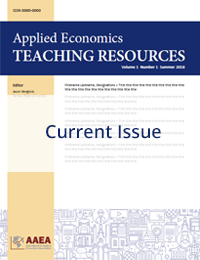Research Article
Valuing College Graduate Attributes and Skills: Employer Willingness to Pay as Elicited through Design Valuation
Ryan Feuz(a) and F. Bailey Norwood(b)
(a)Utah State University
(b)Oklahoma State University
JEL Codes: A20, Q19
Keywords: Academic advising, human resources, interval-censored data, non-market valuation
First Published Online: December 11, 2019
Volume 1, Issue 2
Abstract
Design valuation (DV) is a new valuation method adapted from the Build-Your-Own (BYO) method used within the marketing literature. Within design valuation, subjects design their optimal good by selecting various attributes at select prices. Through a DV survey of college graduate employers, interval-censored willingness-to-pay (WTP) data are collected for 10 college graduate attributes. Both tangible and intangible attributes are evaluated. Average WTP estimates for the college graduate attributes are estimated relative to the type of college (agricultural, business, engineering, or other) from which the employer prefers to hire recent graduates. A high degree of character, ability to work well with others, and excellent communication skills are among the most highly valued attributes. In general, we find that intangible attributes such as these are valued higher than tangible attributes, which require relatively less subjectivity to determine. This finding points to the importance of the job interview, which is often the best tool employers have to evaluate whether candidates possess these intangible attributes. Analysis of the DV survey results will help academic advisors prepare students for the job market and students to better align their own goals with development of specific skills and attributes to increase their marketability and return on education investment on entering the job market.
References
Barkley, A.P. 1992. “Earnings of Kansas State University Agriculture Graduates: 1978-88.” American Journal of Agricultural Economics 74(1):215-222.
Barkley, A. P., W. A. Stock and C.K. Sylvius. 1999. “Agricultural Graduate Earnings: The Impacts of College, Career, and Gender.” American Journal of Agricultural Economics 81:785-800.
Ben-Akiva, M., S. Gershenfeld. 1998. “Multiâ€featured Products and Services: Analyzing Pricing and Bundling Strategies.” Journal of Forecasting 17(3-4): 175-196.
Berle, D. 2007. “Employer Preferences in Landscape Horticulture Graduates: Implications for College Programs.” North American Colleges and Teachers of Agriculture 51(1):21-25.
Boland, M.A. and J.T. Akridge. 2004. “Undergraduate Agribusiness Programs: Focus or Falter?” Review of Agricultural Economics 26(4): 564-578.
Briggeman, B., S.R. Henneberry, and F.B. Norwood. 2007. “How Do Employers Assess Job Candidate Attributes?” North American Colleges and Teachers of Agriculture 51(3): 15-21.
Cawley, J. 2008. “Contingent Valuation Analysis of Willingness to Pay to Reduce Childhood Obesity.” Economics and Human Biology 6(2008):281–292.
Chien, Y-L., C. J. Huang, and D. Shaw. 2005. “A General Model of Starting Point Bias in Double-bounded Dichotomous Contingent Valuation Surveys.” Journal of Environmental Economics and Management 50(2):362–377.
Corso, P. S., J. B. Ingels, and M. I. Roldos. 2013. “A Comparison of Willingness to Pay to Prevent Child Maltreatment Deaths in Ecuador and the United States.” International Journal of Environmental Research and Public Health 10(4):1342–1355.
Day, B. 2007. “Distribution-free Estimation with Interval-censored Contingent Valuation Data: Troubles with Turnbull?” Environmental and Resource Economics 37(4):777–795.
Dahan, E., and J. R. Hauser. 2002. “The Virtual Customer.” The Journal of Product Innovation Management 19(2002):332–353.
Green, D., K. E. Jacowitz, D. Kahneman, and D. McFadden. 1998. “Referendum Contingent Valuation, Anchoring, and Willingness to Pay for Public Goods.” Resource and Energy Economics 20(2):85–116.
Green, P. E., and V. Srinivasan. 1990. “Conjoint Analysis in Marketing: New Developments with Implications for Research and Practice.” Journal of Marketing 54(4):3–19.
Harris, K. D., and B. C. Briggeman. 2019. “Job Attribute Preferences of Undergraduate Agricultural Majors—Do They Match with Careers in Grain Merchandising?” Applied Economics Teaching Resources 1(1):1–17.
Kato, T., and N. Hidano. 2007. “Anchoring Effects, Survey Conditions, and Respondents’ Characteristics: Contingent Valuation of Uncertain Environmental Changes.” Journal of Risk Research 10(6):773–792.
Khalili, A. 2012. “The Role of Emotional Intelligence in the Workplace: A Literature Review.” International Journal of Management 29(3):355–370.
Liechty, J., V. Ramaswamy, and S. H. Cohen. 2001. “Choice Menus for Mass Customization: An Experimental Approach for Analyzing Customer Demand with an Application to a Web-based Information Service.” Journal of Marketing Research 38(2):183–196.
Litzenberg, K. K., and V. E. Schneider. 1987. “Competencies and Qualities of Agricultural Economics Graduates Sought by Agribusiness Employers.” American Journal of Agricultural Economics 69(5):1031–1036.
Lusk, J., and D. Hudson. 2004. “Willingness-to-pay Estimates and Their Relevance to Agribusiness Decision Making.” Review of Agricultural Economics 26(2):152–169.Page | 30 Volume 1, Issue 2, December 2019
Noel, J., and E. Qenani. 2013. “New Age, New Learners, New Skills: What Skills Do Agribusiness Graduates Need to Succeed in the Knowledge Economy?” International Food and Agribusiness Management Review 16(3):17–36.
Norwood, F. B., and S. R. Henneberry. 2006. “Show Me the Money! The Value of College Graduate Attributes as Expressed by Employers and Perceived by Students.” American Journal of Agricultural Economics 88(2):484–498.
Rosen, S. 1974. “Hedonic Prices and Implicit Markets: Product Differentiation in Pure Competition.” Journal of Political Economy 82(1):34–55.
StataCorp. 2019. Stata 16 Base Reference Manual. College Station, TX: Stata Press.
Suleman, F. 2016. “Employability Skills of Higher Education Graduates: Little Consensus on a Much-discussed Subject.” Procedia-Social and Behavioral Sciences 228:169–174.
Turnbull, B. W. 1974. “Nonparametric estimation of a survivorship function with doubly censored data.” Journal of the American Statistical Association 69(345):169-173.
Velasco, M. S. 2012. “More Than Just Good Grades: Candidates’ Perceptions about the Skills and Attributes Employers Seek in New Graduates.” Journal of Business Economics and Management 13(3):499–517.
Park, Y-H., M. Ding, and V. R. Rao. 2008. “Eliciting Preference for Complex Products: A Web-based Upgrading Method.” Journal of Marketing Research 45(5): 562–574.
Articles in this issue
Outstanding Seniors: Where Have All the Young Men Gone?
Paul Wilson and Na Zuo
Valuing College Graduate Attributes and Skills: Employer Willingness to Pay as Elicited through Design Valuation
Ryan Feuz and F. Bailey Norwood
An Authentic Learning Approach to Group Assignments: An Analysis of Student Attitudes
Roger Brown, Na Zuo, Jordan Shockley, and Steven Buck
Teaching Competition Topics: Applications of Seller Market Power in Agricultural Industries
Yuliya V. Bolotova
The Project Manager / Private Contractor Approach to Group Assignments
Roger Brown, Na Zuo, Jordan Shockley, and Steven Buck


